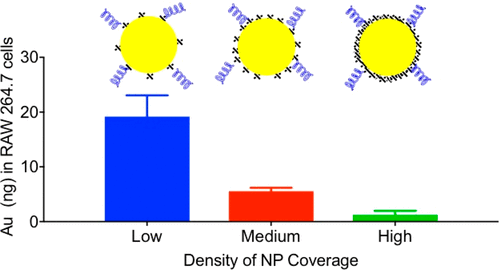Our official English website, www.x-mol.net, welcomes your
feedback! (Note: you will need to create a separate account there.)
Coating Metal Nanoparticle Surfaces with Small Organic Molecules Can Reduce Nonspecific Cell Uptake
ACS Nano ( IF 15.8 ) Pub Date : 2018-01-08 00:00:00 , DOI: 10.1021/acsnano.7b03025 Desiree Van Haute 1 , Alice T Liu 1 , Jacob M Berlin 1
ACS Nano ( IF 15.8 ) Pub Date : 2018-01-08 00:00:00 , DOI: 10.1021/acsnano.7b03025 Desiree Van Haute 1 , Alice T Liu 1 , Jacob M Berlin 1
Affiliation

|
Elucidation of mechanisms of uptake of nanoparticles by cells and methods to prevent this uptake is essential for many applications of nanoparticles. Most recent studies have focused on the role of proteins that coat nanoparticles and have employed PEGylation, particularly dense coatings of PEG, to reduce protein opsonization and cell uptake. Here we show that small molecule coatings on metallic nanoparticles can markedly reduce cell uptake for very sparsely PEGylated nanoparticles. Similar results were obtained in media with and without proteins, suggesting that protein opsonization is not the primary driver of this phenomenon. The reduction in cell uptake is proportional to the degree of surface coverage by the small molecules. Probing cell uptake pathways using inhibitors suggested that the primary role of increased surface coverage is to reduce nanoparticles’ interactions with the scavenger receptors. This work highlights an under-investigated mechanism of cell uptake that may have played a role in many other studies and also suggests that a wide variety of molecules can be used alongside PEGylation to stably passivate nanoparticle surfaces for low cell uptake.
中文翻译:

用有机小分子涂覆金属纳米颗粒表面可以减少非特异性细胞摄取
阐明细胞吸收纳米颗粒的机制和防止这种吸收的方法对于纳米颗粒的许多应用是必不可少的。最近的研究集中在包裹纳米颗粒的蛋白质的作用,并采用聚乙二醇化,特别是聚乙二醇的致密涂层,以减少蛋白质调理作用和细胞摄取。在这里,我们表明金属纳米粒子上的小分子涂层可以显着减少非常稀疏的聚乙二醇化纳米粒子的细胞摄取。在含有和不含蛋白质的培养基中获得了类似的结果,这表明蛋白质调理作用不是这种现象的主要驱动力。细胞摄取的减少与小分子的表面覆盖程度成正比。使用抑制剂探测细胞摄取途径表明,增加表面覆盖的主要作用是减少纳米颗粒与清道夫受体的相互作用。这项工作强调了一种未被充分研究的细胞摄取机制,该机制可能在许多其他研究中发挥了作用,并且还表明,多种分子可以与聚乙二醇化一起使用,以稳定地钝化纳米颗粒表面以实现低细胞摄取。
更新日期:2018-01-08
中文翻译:

用有机小分子涂覆金属纳米颗粒表面可以减少非特异性细胞摄取
阐明细胞吸收纳米颗粒的机制和防止这种吸收的方法对于纳米颗粒的许多应用是必不可少的。最近的研究集中在包裹纳米颗粒的蛋白质的作用,并采用聚乙二醇化,特别是聚乙二醇的致密涂层,以减少蛋白质调理作用和细胞摄取。在这里,我们表明金属纳米粒子上的小分子涂层可以显着减少非常稀疏的聚乙二醇化纳米粒子的细胞摄取。在含有和不含蛋白质的培养基中获得了类似的结果,这表明蛋白质调理作用不是这种现象的主要驱动力。细胞摄取的减少与小分子的表面覆盖程度成正比。使用抑制剂探测细胞摄取途径表明,增加表面覆盖的主要作用是减少纳米颗粒与清道夫受体的相互作用。这项工作强调了一种未被充分研究的细胞摄取机制,该机制可能在许多其他研究中发挥了作用,并且还表明,多种分子可以与聚乙二醇化一起使用,以稳定地钝化纳米颗粒表面以实现低细胞摄取。











































 京公网安备 11010802027423号
京公网安备 11010802027423号